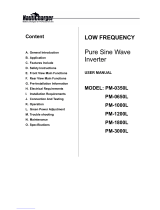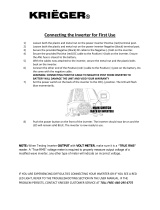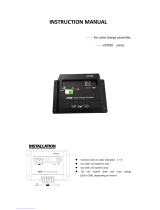
8 | SAMLEX AMERICA INC. SAMLEX AMERICA INC. | 9
SECTION 3 | Characteristics of Sinusoidal AC Power
VOLTAGE, CURRENT, POWER FACTOR, TYPES OF LOADS
The voltage waveform of 120 VAC, 60 Hz mains / utility power is like a sine wave (see
Fig 8.1, page 30). In a voltage with a sine wave-form, the instantaneous value and
polarity of the voltage varies with respect to time and the wave-form is like a sine wave.
In one cycle, it slowly rises in the Positive direction from 0V to a peak Positive value +
Vpeak = 170V, slowly drops to 0V, changes the polarity to Negative direction and slowly
increases in the Negative direction to a peak Negative value - Vpeak =170V and then
slowly drops back to 0V. There are 60 such cycles in 1 sec. Cycles per second is called the
“frequency” and is also termed “Hertz (Hz). If a linear load is connected to this type
of voltage, the load will draw current which will also have the same sine wave-form.
However, the peak value of the current will depend upon the impedance of the load.
Also, the phase of the sine wave-form of the current drawn by the linear load may be
the same or lead / lag the phase of sine wave-form of the voltage. This phase difference
determines the “Power Factor (mathematically = the Cosine of the phase difference)” of
the load. In a resistive type of load (like incandescent lamps, heaters etc) the sine wave-
form of the current drawn by the load has 0 phase difference with the sine wave-form
of the voltage of the AC power source. The Power Factor of a resistive load is unity (1).
The rated output power (in Watts) of the inverters is normally specied for resistive type
of loads that have unity (1) Power Factor. In a reactive type of load (like electric motor
driven loads, uorescent lights, computers, audio / video equipment etc), the phase of
the sine wave-form of the current drawn by the load may lead or lag the sine wave-
form of the AC voltage source. In this case, the Power Factor of reactive loads is lower
than unity (1) – generally between 0.8 and 0.6. A reactive load reduces the effective
wattage that can be delivered by an AC power source.
RMS AND PEAK VALUES
As explained above, in a sine wave (Fig 8.1, page 30), the instantaneous values of AC
voltage (Volt, V) and current (Ampere, A) vary with time. Two values are commonly
used – Root Mean Square (RMS) value and peak value. For simplicity, RMS value can be
considered as an average value. Mathematically, Peak Value = 1.414 x RMS value. For
example, the 120 VAC, 60Hz mains / utility power is the RMS value. The peak value cor-
responding to this is = 1.414 x 120 = 170V. The values of the rated output voltage and
current of an AC power source are their RMS values.
AC POWER – WATTS / VA
- The power rating of an AC power source is designated in Volt Amperes (VA)
or in Watts (W)
- Power in Volt Amperes (VA) = RMS Volts (V) x RMS Amps (A)
- Power in Watts = RMS Volts (V) x RMS Amps (A) x Power Factor
NOTE: The rated power of the inverter in Watts (W) is normally designated for a linear,
resistive type of load that draws linear current at unity (1) Power Factor. If the load is
linear and reactive type, the rated power of the inverter in watts will be limited to its
normal rated power in watts (W) x Power Factor. For example, an inverter rated for
1000W (at unity Power Factor) will be able to deliver only 600W to a reactive type
of load with a Power Factor of 0.6.























